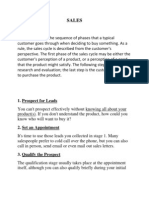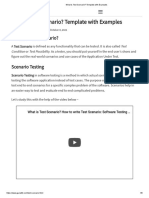0 ratings0% found this document useful (0 votes)
83 viewsHow To Close A Deal in b2b
How To Close A Deal in b2b
Uploaded by
RAMLAH AKBERB2B sales often involve larger transactions, educated customers, and a longer sales cycle. To close a B2B deal, it is important to understand the customer's problems and show how your solution addresses them. Some effective strategies for closing B2B deals include meeting with customers in person, using case studies to demonstrate past success, clearly communicating your value proposition, and focusing your language on collaboration rather than separation from the customer. Tracking outcomes also allows sales teams to continually improve performance.
Copyright:
© All Rights Reserved
Available Formats
Download as DOCX, PDF, TXT or read online from Scribd
How To Close A Deal in b2b
How To Close A Deal in b2b
Uploaded by
RAMLAH AKBER0 ratings0% found this document useful (0 votes)
83 views4 pagesB2B sales often involve larger transactions, educated customers, and a longer sales cycle. To close a B2B deal, it is important to understand the customer's problems and show how your solution addresses them. Some effective strategies for closing B2B deals include meeting with customers in person, using case studies to demonstrate past success, clearly communicating your value proposition, and focusing your language on collaboration rather than separation from the customer. Tracking outcomes also allows sales teams to continually improve performance.
Original Title
How to close a deal in b2b
Copyright
© © All Rights Reserved
Available Formats
DOCX, PDF, TXT or read online from Scribd
Share this document
Did you find this document useful?
Is this content inappropriate?
B2B sales often involve larger transactions, educated customers, and a longer sales cycle. To close a B2B deal, it is important to understand the customer's problems and show how your solution addresses them. Some effective strategies for closing B2B deals include meeting with customers in person, using case studies to demonstrate past success, clearly communicating your value proposition, and focusing your language on collaboration rather than separation from the customer. Tracking outcomes also allows sales teams to continually improve performance.
Copyright:
© All Rights Reserved
Available Formats
Download as DOCX, PDF, TXT or read online from Scribd
Download as docx, pdf, or txt
0 ratings0% found this document useful (0 votes)
83 views4 pagesHow To Close A Deal in b2b
How To Close A Deal in b2b
Uploaded by
RAMLAH AKBERB2B sales often involve larger transactions, educated customers, and a longer sales cycle. To close a B2B deal, it is important to understand the customer's problems and show how your solution addresses them. Some effective strategies for closing B2B deals include meeting with customers in person, using case studies to demonstrate past success, clearly communicating your value proposition, and focusing your language on collaboration rather than separation from the customer. Tracking outcomes also allows sales teams to continually improve performance.
Copyright:
© All Rights Reserved
Available Formats
Download as DOCX, PDF, TXT or read online from Scribd
Download as docx, pdf, or txt
You are on page 1of 4
How to close a deal in B2B
What is B2B sales?
Instead of being between a business and a customer for the consumer's own use,
business-to-business (B2B) sales are transactions between two firms. Larger
transaction amounts, educated customers, a multi-stakeholder clearance procedure,
and a consequently lengthier sales cycle are characteristics of business-to-business
(B2B) sales.
If you've done your job of guiding the customer through the sales process properly,
you've already conducted a requirements analysis, tailored a proposal, had some
trial closures, and are now prepared to start working. To make a sale, you must
first identify the customer's problems and then show them how your solution will
address those issues.
From a leadership standpoint, it's critical that you have faith in your salespeople's
ability to employ the appropriate approaches based on the circumstance of the sale
they find themselves in. There are several sales strategies available. B2B sales can
be difficult to close, and the market is getting more and more cutthroat. Particularly
in a dynamic, digital environment. Additionally, the more sales your business
needs to expand, the more demanding it is on your firm.
1. Create a profile of your ideal customer.
Spend some time determining which businesses best suit your desired clientele. Be
on the lookout for contextual information about how business is going in addition
to what your prospects sell or provide. Has a new product just been introduced?
Did the startup you are selling just complete a round of fundraising? Has the
leadership changed at all in the previous six months? This information is a useful
supplement to your buyer persona data and may assist you in determining whether
businesses are prepared to invest in your services.
2. Consideration
Your potential customer is still considering their alternatives and comparing your
goods to that of your rivals during the contemplation stage.
Your potential customer is searching for the product that will best alleviate their
problems. Sending them material that convinces them about your product and aids
in their transition to the acquisition stage is a fantastic idea at this point. Sending
them case studies, comparative guides, and free trials or demos are a few examples
of material.
3. Having no problem with walking away
Saying no and leaving while you are speaking to the CEO or the decision-maker
may be quite effective.
The prospect will be aware that they are a good fit if you have done your job
effectively. They will explain why they are if you suggest they aren't. No matter
what it is, no one like being told they cannot have anything. And they have the
authority to make it happen if they are the CEO or the decision-maker.
4. Create a process map based on your buyer's journey.
By aligning your process with the buyer's journey, you may concentrate strategy
and financial resources on the touchpoints that will have the most impact. For
instance, you might switch your marketing initiatives from raising brand
recognition to developing websites that offer the most benefit to potential
customers who are already considering your brand.
Making a plan also enables the adoption of good measures of brand performance,
the efficacy of marketing spending, and consumer attitude. By doing so, you can:
Keep up with consumer requirements and device-specific solutions
Make careful financial decisions while making sure prospects receive the "correct"
information at the appropriate time.
5. Value Selling Framework
This type of selling is focused on the product being sold and builds on its inherent
value. This value-added sales strategy necessitates input from a certain range of
typical consumer understanding. These clients will assist the sales and marketing
executives in developing value propositions that are likely to set the product apart
from rivals and provide the greatest number of clients with advantages.
The steps in the process are: qualifying your prospect/ identifying decision-makers
with the authority to make decisions/ positioning your capabilities/ differentiating
your offer/ developing a shared strategy/ posing pertinent questions and concluding
the sale
6. Meet in person.
Try to speak face-to-face as often as you can if you discover that the demands of
the consumer and your products or services are compatible. As we've just
established, B2B transactions frequently involve more thought and have larger
risks. You may develop a level of trust with the consumer that isn't always possible
over the phone or via email when you are able to meet face-to-face (in person or
via video) to answer questions, make your pitch, and address concerns.
7. Case studies can be used in B2B sales pitches.
Social proof is a fantastic B2B sales tactic to use. Even the most enthusiastic
customers still need proof that you can meet their needs. Case studies have to be
created using examples of client achievement. Include client endorsements, a list of
the goods and services you provided, and an explanation of how each helped
clients.
Case studies are effective closing techniques because they show how your business
has benefited others. Include information on how your product benefited
customers, such as how it increased revenue, streamlined processes, boosted
customer happiness, or improved net promoter scores.
8. Analyze outcomes and get better.
In order to continually improve, high-performing sales teams track the outcomes of
their operations. You and your team may increase productivity and overall
performance when you frequently monitor and work to improve the outcomes of
your company's B2B sales KPIs.
9. Be very explicit regarding your value proposition
Make sure you understand the distinctive value proposition of your solution before
connecting with potential clients. Deals in business-to-business sales frequently
have larger financial values and stakes by nature. You must be able to clearly
communicate the value your service provides to the potential consumer if you want
to close the deal. Any prospective customer you interact with should be able to
comprehend the issue your solution seeks to address. This is referred to as a value
proposition when put into words.
Create B2B Sales about "Us" Instead of "You"
The customer will be impacted by the language you use in B2B sales
conversations. Use "we" and "us" instead of "I" and "You," which distances your
client from your business. By using language like this, you essentially inform your
customers that they will become your partners, putting you on an equal footing
with them. For example:
How are "we" supposed to decide what to do next?
When may "we" start?
For "us," this is the ideal option.
You might also like
- Nitroba ReportDocument11 pagesNitroba Reportboyka g100% (2)
- Sales Pipeline Academy Ebook by PipedriveDocument48 pagesSales Pipeline Academy Ebook by PipedriveMughal HijabNo ratings yet
- Steve W. Martin: BooksDocument8 pagesSteve W. Martin: BooksParvez2zNo ratings yet
- The Ultimate Guide To Sales Planning SeasonDocument24 pagesThe Ultimate Guide To Sales Planning SeasonFernando Lázaro100% (1)
- The Challenger Sale: Commercial Teaching and Your Sales PresentationDocument26 pagesThe Challenger Sale: Commercial Teaching and Your Sales Presentationsampige123No ratings yet
- Transforming B2B Customer Engagement at 3MDocument13 pagesTransforming B2B Customer Engagement at 3MSachinNo ratings yet
- IQ204 - ADL Autodialling Controller Data Sheet - TrendDocument12 pagesIQ204 - ADL Autodialling Controller Data Sheet - TrendToni TrifuNo ratings yet
- Case StudiesDocument44 pagesCase Studies...No ratings yet
- Sales ProcessDocument7 pagesSales ProcessRodrigo MedinaNo ratings yet
- 5 Sales Prospecting Myths Debunked PDFDocument10 pages5 Sales Prospecting Myths Debunked PDFMarcelo Partes de OliveiraNo ratings yet
- Sales FunnelDocument6 pagesSales Funnelparth_upadhyay_1No ratings yet
- Analysis of The Sales ProcessDocument12 pagesAnalysis of The Sales ProcessSameena YusufNo ratings yet
- Strategic Sales Pipeline Management1Document10 pagesStrategic Sales Pipeline Management1AbrahamRosh100% (6)
- Sales Training 2Document37 pagesSales Training 2akbarNo ratings yet
- For Sales Supervisor and Sales ManagerDocument18 pagesFor Sales Supervisor and Sales Managerprince husainNo ratings yet
- Sales Force Competencies Sales Force CompetenciesDocument28 pagesSales Force Competencies Sales Force CompetenciesRamanamurthy Saripalli100% (1)
- 6 Critical Success Factors For B2B Lead Generation Ebook%5b1%5dDocument10 pages6 Critical Success Factors For B2B Lead Generation Ebook%5b1%5dHarpreet SinghNo ratings yet
- Sales Training: The Seven Steps of The SaleDocument12 pagesSales Training: The Seven Steps of The SaleVetri M KonarNo ratings yet
- Sales Rep Annual Skills AuditDocument3 pagesSales Rep Annual Skills AuditHappy DealNo ratings yet
- Annual Sales KickoffsDocument11 pagesAnnual Sales KickoffsCam Uno100% (2)
- Sales ContestDocument12 pagesSales Contestashi9812No ratings yet
- Sales: 1. Prospect For LeadsDocument14 pagesSales: 1. Prospect For LeadsHira AbidNo ratings yet
- Sales Call ChecklistDocument3 pagesSales Call Checklistkashif.kudalkar7067100% (1)
- Sales TrainingDocument28 pagesSales TrainingEbram LouisNo ratings yet
- Sales Planning: A Dream Is Just A Dream. A Goal Is A Dream With A Plan and A Deadline. - Harvey MackayDocument25 pagesSales Planning: A Dream Is Just A Dream. A Goal Is A Dream With A Plan and A Deadline. - Harvey MackayParas SetiaNo ratings yet
- B2B Cold Calling Sales ScriptDocument2 pagesB2B Cold Calling Sales ScriptManoj Kumar SharmaNo ratings yet
- Sales Plan TemplateDocument17 pagesSales Plan Templateramesh100% (1)
- Management of Sales TerritoriesDocument30 pagesManagement of Sales TerritoriesAditya Shukla100% (1)
- 100 Sales Tips For 2017Document52 pages100 Sales Tips For 2017Paulo de Castro100% (1)
- Sales ArticleDocument7 pagesSales ArticlePrasad DharankarNo ratings yet
- Sales Leaders Guide To B2B Sales Growth Infographic PDFDocument1 pageSales Leaders Guide To B2B Sales Growth Infographic PDFMarcelo Partes de OliveiraNo ratings yet
- Personal Selling and TrainingDocument24 pagesPersonal Selling and TrainingDibakar DasguptaNo ratings yet
- ANA Achieving Corporate Sales TargetsDocument8 pagesANA Achieving Corporate Sales TargetsDemand Metric100% (1)
- Closing A SaleDocument4 pagesClosing A SaleRAMLAH AKBERNo ratings yet
- Process of Sales ManagementDocument7 pagesProcess of Sales ManagementShoaibNo ratings yet
- Major Sales Strategy-JayeshDocument13 pagesMajor Sales Strategy-JayeshjayeshNo ratings yet
- Open Ended Sales QuestionDocument3 pagesOpen Ended Sales Questionriccardo mainiNo ratings yet
- The Ultimate Guide To Sales MetricDocument17 pagesThe Ultimate Guide To Sales MetricLinn Linn Tun50% (2)
- The Playbook For Sales ManagementDocument22 pagesThe Playbook For Sales ManagementRustam KoshelevNo ratings yet
- Key Account ManagementDocument3 pagesKey Account Managementanshu8jyotiNo ratings yet
- OpenMind: Sales Training CourseDocument4 pagesOpenMind: Sales Training CourseopenaxyzNo ratings yet
- AKSH People TransformationDocument12 pagesAKSH People TransformationjayadevmNo ratings yet
- Eades Solution Selling ConferenceDocument35 pagesEades Solution Selling ConferencekberbertNo ratings yet
- How To Build Pipeline in 2017 Sales Development (PDFDrive)Document63 pagesHow To Build Pipeline in 2017 Sales Development (PDFDrive)Luis Iván De la FuenteNo ratings yet
- Sales Follow Up GuideDocument19 pagesSales Follow Up GuideMagic FactsNo ratings yet
- 9 Steps To Boost Sales ProductivityDocument12 pages9 Steps To Boost Sales ProductivityEstevão K. SchuhNo ratings yet
- Recruitment & Selection of Sales Personnel FinaleDocument45 pagesRecruitment & Selection of Sales Personnel FinalezampakNo ratings yet
- The Way To Sell: Powered byDocument25 pagesThe Way To Sell: Powered bysagarsononi100% (1)
- Session 2 Sales StrategyDocument115 pagesSession 2 Sales StrategyAkash GagnejaNo ratings yet
- 2 Bonding Building Rapport - Sandler FoundationsDocument16 pages2 Bonding Building Rapport - Sandler FoundationsJose Ivan Miranda CamposNo ratings yet
- The Complete Guide - How To Master TelemarketingDocument17 pagesThe Complete Guide - How To Master TelemarketingOnly B2B100% (1)
- The Best Sales Books Summarized - Pages-1-7 PDFDocument7 pagesThe Best Sales Books Summarized - Pages-1-7 PDFPankaj DahiyaNo ratings yet
- Dr. Sanjeev PrasharDocument36 pagesDr. Sanjeev PrasharPrateek AroraNo ratings yet
- Car Dealer Lead Management Process Map With Indexed TemplatesDocument4 pagesCar Dealer Lead Management Process Map With Indexed TemplatesRalph PagliaNo ratings yet
- Value Added SellingDocument8 pagesValue Added Sellingyashraj1105No ratings yet
- Dell - Selling Process and Lead GenerationDocument8 pagesDell - Selling Process and Lead GenerationAbhishek MandaviyaNo ratings yet
- Improving Sales PerformanceDocument5 pagesImproving Sales PerformanceKeith Parker0% (1)
- Whitepaper 10 Qualities of Great ConsultantsDocument10 pagesWhitepaper 10 Qualities of Great Consultantsapi-538826312No ratings yet
- Account Executive Job DescriptionDocument2 pagesAccount Executive Job DescriptionSony SanjayaNo ratings yet
- Printing N Publishing Sales PitchDocument2 pagesPrinting N Publishing Sales PitchSameer GargNo ratings yet
- Sales: Your Business Accelerator: The Performance Manager SeriesDocument15 pagesSales: Your Business Accelerator: The Performance Manager SeriestsysNo ratings yet
- Core Java Sem 4 Jan2019 ExamDocument2 pagesCore Java Sem 4 Jan2019 ExamRaj MishraNo ratings yet
- Kumar 2018Document21 pagesKumar 2018NUR SUKMAWATINo ratings yet
- Lecture 1 - Introduction To Computers PDFDocument18 pagesLecture 1 - Introduction To Computers PDFShannil Ariveen MahendranNo ratings yet
- Rainastar Sinchai Marmat SAMBHARDocument10 pagesRainastar Sinchai Marmat SAMBHARLaxu KhanalNo ratings yet
- Module 3 - Drain and Vent Pipe SystemDocument3 pagesModule 3 - Drain and Vent Pipe SystemsimbrananneNo ratings yet
- Condenstae StabilizationDocument3 pagesCondenstae StabilizationsatishchemengNo ratings yet
- Martin G 2019 PHD ThesisDocument324 pagesMartin G 2019 PHD ThesisMenderes TarcanNo ratings yet
- CS-262 Problem Set 1Document6 pagesCS-262 Problem Set 1FAHAD KARIM KHANNo ratings yet
- Hot Strip Mill Descale Nozzle UpgradeDocument8 pagesHot Strip Mill Descale Nozzle UpgradeRakhee SinhaNo ratings yet
- Chapter 1 To 4Document45 pagesChapter 1 To 4phoenixgirl1980zNo ratings yet
- External Sorting: R & G - Chapter 13Document52 pagesExternal Sorting: R & G - Chapter 13raw.junkNo ratings yet
- OS - How To Write An Objective Statement For Six SigmaDocument7 pagesOS - How To Write An Objective Statement For Six SigmaCoYONo ratings yet
- International Standard: Test Sieves - Technical Requirements and Testing - Test Sieves of Metal Wire ClothDocument8 pagesInternational Standard: Test Sieves - Technical Requirements and Testing - Test Sieves of Metal Wire Clothbba.amira71728No ratings yet
- Smart Electricity Tracking SystemDocument6 pagesSmart Electricity Tracking Systemwapifiy411No ratings yet
- 1a. Ert-Ctt-2 Cellular Mobile Phone Trainer Exp Man PT Len Ind 9716Document81 pages1a. Ert-Ctt-2 Cellular Mobile Phone Trainer Exp Man PT Len Ind 9716Mayang Enggar KusumastutiNo ratings yet
- Rtos - MCQDocument20 pagesRtos - MCQpavanNo ratings yet
- Build A Small NetworkDocument39 pagesBuild A Small Networksofyankp mtmNo ratings yet
- Chanakya Neeti by RP Jain B01fawghaoDocument5 pagesChanakya Neeti by RP Jain B01fawghaoRakesh Kumar RautarayNo ratings yet
- JohnFailingResume 2021Document5 pagesJohnFailingResume 2021Manas RanjanNo ratings yet
- Glycol Dehydration Unit English LetterDocument4 pagesGlycol Dehydration Unit English LetterRaulCamachoNo ratings yet
- For Guidance: Australasian HFG Standard Components DTUR-14 Dirty Utility, 14MDocument1 pageFor Guidance: Australasian HFG Standard Components DTUR-14 Dirty Utility, 14MChristdel VivarNo ratings yet
- Installation Instructions ForDocument17 pagesInstallation Instructions Forkilofome05No ratings yet
- LabWare 8 BrochureDocument8 pagesLabWare 8 BrochureLAURA SOFIA JIMENEZ GUTIERRENo ratings yet
- MHF4U - Polynomial TestDocument5 pagesMHF4U - Polynomial Testsriram5555No ratings yet
- Study of The U.S. Institutes (SUSI) For Student Leaders Nomination FormDocument6 pagesStudy of The U.S. Institutes (SUSI) For Student Leaders Nomination FormKeithNo ratings yet
- XVL Player Ver. 12.1a Menu ListDocument5 pagesXVL Player Ver. 12.1a Menu ListKAUR DISPARIPORANo ratings yet
- What Is Test Scenario - Template With ExamplesDocument3 pagesWhat Is Test Scenario - Template With ExamplesFlorin ConduratNo ratings yet

























































































